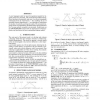Free Online Productivity Tools
i2Speak
i2Symbol
i2OCR
iTex2Img
iWeb2Print
iWeb2Shot
i2Type
iPdf2Split
iPdf2Merge
i2Bopomofo
i2Arabic
i2Style
i2Image
i2PDF
iLatex2Rtf
Sci2ools
CORR
2000
Springer
2000
Springer
Recognition Performance of a Structured Language Model
A new language model for speech recognition inspired by linguistic analysis is presented. The model develops hidden hierarchical structure incrementally and uses it to extract meaningful information from the word history -- thus enabling the use of extended distance dependencies -- in an attempt to complement the locality of currently used trigram models. The structured language model, its probabilistic parameterization and performance in a two-pass speech recognizer are presented. Experiments on the SWITCHBOARD corpus show an improvement in both perplexity and word error rate over conventional trigram models.
| Added | 17 Dec 2010 |
| Updated | 17 Dec 2010 |
| Type | Journal |
| Year | 2000 |
| Where | CORR |
| Authors | Ciprian Chelba, Frederick Jelinek |
Comments (0)

